Allen Tiller's Blog, page 5
May 28, 2024
GREAT FIRE IN RUNDLE-STREET. 1879
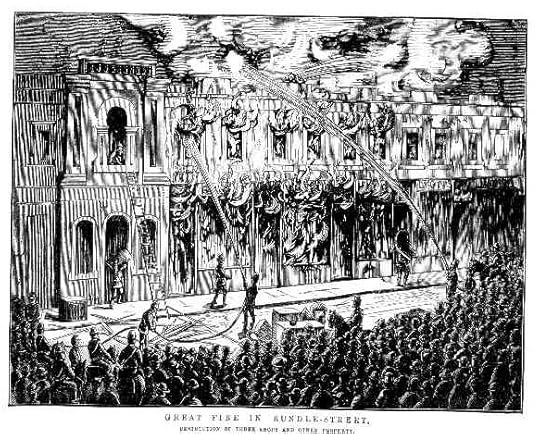
For the size of thecity Adelaide has been comparatively free from the "fire demon"for a very long time. The hot weather of the past week has however brought withit a larger number of fires than has ever occurred during a likeperiod since the colony has existed.
The subject of our illustration was the largest fire we have ever hadhere. It began soon after 9 o'clock on the evening of February 5th, and beforeit was got under (at about 11 o'clock) no fewer than three shops and premiseswere completely gutted. The names of the persons whose premises were entirelydestroyed were L. Veroli (insured), Mr. Barry (not insured), Mr. Haylock (not insured).Besides these the adjoining premises of Messrs. Jamieson, Lyons, and the E.S.& A.C. Bank, were all considerably damaged both by fire andwater.
We believe that fully £10,000 worth ofdamage was done. The thoroughfare was completely blockaded for several hours bya mass of people, and there could not have been less than 10,000 persons present.A great part of the salvage goods were stolen, whilst the furnitureand personal effects were more damaged by being tumbled about the streets thanby any other cause.
Mr. Richard Vaughanis the proprietor of the whole of the buildings, but we believe he will notlose anything, being fully insured. At the inquest nothing was elicited to showhow the fire originated, and we suppose it will therefore for everremain a mystery.
Besides thelarge fire, there has been several others during the past few days,at the King of Hanover stables, at Kent Town, in Hindley-street, andlastly at the Adelaide Photographic Company's in King William-street. Altogether,Adelaide has had enough fires to last a long time, and we sincerely hopeit will be a long time ere we have to chronicle so disastrous a fire asis depicted on our front page. It is from a sketch taken on the spot.
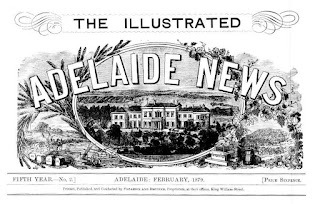
'Our Illustrations', The Illustrated Adelaide News,(1 February 1879), p. 3., http://nla.gov.au/nla.news-article224...
May 7, 2024
Loveday – Part 4 – Camp 10
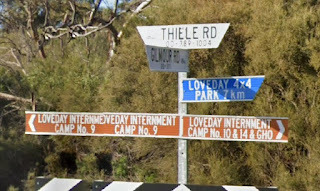
The Loveday Internment Camp complex was the largest construction of its type in Australia, and the only purpose-built World War II internment facility in South Australia. It comprised a garrison barracks and administration building, camps 9, 10 and 14; a piggery and other farming facilities, and included three woodcutting camps at Katarapko, Woolenook Bend and Moorook West.[1] Other Internment facilities were a temporary facility at Keswick Army Barracks in 1939/40. Gladstone Gaol was used for Italian detainees, who worked forestry jobs at Wirrabara and Bundaleer. There was also a temporary internment camp at Sandy Creek that housed Italian detainees who worked on farms in the Adelaide Hills. Before this, the camp had been constructed to house American troops. A section of fence from this camp still exists on Williamstown Road.[2]
Camp 10, accepted detainees from, June 1941 until January 1944, when all detainees were transferred to camp 14. At the end of the war, most of the structures at the camp were sold and relocated, however, the camp 10 cell block remains in situ. The cell block was built originally as a two-cell facility but was later expanded to six cells. Detainees housed here were for crimes inside the camps, such as espionage, physical violence against other inmates, disobedience, and escape attempts. Australian soldiers with the 25/23 Garrison Battalion, due for court-martial hearings also spent time in these buildings. (One, who worked in the mail room, was accused of opening Red Cross packages sent to detainees and stealing their cigarettes.)[3] These three detained Australian soldiers inscribed their names on the cell’s walls.[4]
Camp 10 was officially closed on 9 January 1944. It was then converted to a Detail Issue Depot (DID). DIDs were used for storing and distributing basic supplies to the various camps.[5] The camp was closed in 1946, and individual campsites were sold as properties. In 1947, the piggeries and 43 acres of land were sold to ex-servicemen.[6]
In 1989, The General Headquarters site at Loveday Internment Camp Complex was entered into the South Australian Heritage Register. In 1991, an archaeological survey was conducted at the location. The Loveday Internment Camp Committee is investigating the potential of turning the former cell block into a tourist attraction.[7]
Researched and written by Allen Tiller © 2024
[1] Camp 10 Detention Cell Block – Loveday Internment Camp Complex., Department of Environment and Water, (2020), p. 14.
[2] Ibid., pp. 2-3.
[3] 'Prisoners' Camp Allegations', News, (28 April 1944), p. 3.
[4] Camp 10 Detention Cell Block – Loveday Internment Camp Complex., Department of Environment and Water, (2020), p. 19-20.
[5] The Details Issue Depot, Australian War Memorial, (2023), https://www.awm.gov.au/collection/ART....
[6] 'Loveday Camp Closing', The Advertiser, (21 January 1947), p. 2.
[7] Loveday Internment Camp, Berri Barmera Council, (March 2023), https://lovedayinternmentcamp.au/.
April 30, 2024
Loveday – Part 3: Tunnel
Loveday – Part 3: Tunnel
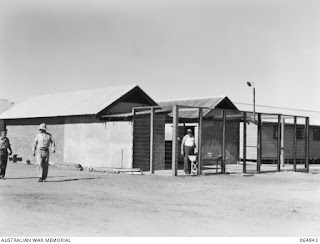
Barmera, South Australia. 1943-03-11/17. Detention cells ofthe 10th Australian prisoner of war and internment camp, loveday group.(Australian War Memorial)
Loveday internment camp had many escape attempts, the most notable being a tunnel dug from under a tent near a permitter fence, which came out on the other side of the barbwire fence, hidden by a bush.
The tunnel was deep enough underground that trucks passing over the top on the road did not collapse it. To get around the large amounts of dirt being pulled from the tunnel excavation, prisoners asked for permission to make a mud brick hut, which was granted. Surprisingly, no officers questioned where the dirt was coming from.
Internees used kitchen knives to dig the tunnels, with prisoners using handkerchiefs to cart the dirt from the tunnel. The dirt that wasn’t used for mud bricks was spread around the camp day and night, without soldiers realising.
On 30 April 1942 three internees reported to a guard that they believed there would be a mass escape that evening. The three men were removed from the camp for their own safety. An inspection of the entirety of Camp 10 revealed the tunnel. It was thought that within a few hours of the report to the guard, the tunnel would have been big enough for the escape. Soldiers filled the tunnel with water and collapsed it.[1]
Researched and written by Allen Tiller © 2024
[1] Max Scholz, ‘As I Remember: The Loveday Interment Camp,’ (Barmera, 2004), pp. 32-33.
'Last Prisoners Have Left Loveday', Murray Pioneer, (23 January 1947), p. 1.
April 24, 2024
'The Soldiers' Farewell. South Australians off to the War. Monday's Parade
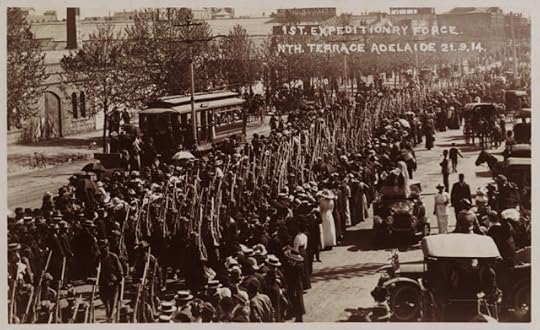 Farewell parade of the first contingent of South Australian soldiers for the First World WarSLSA [B 30437]
Farewell parade of the first contingent of South Australian soldiers for the First World WarSLSA [B 30437]
"The parade was a triumph of faith, hope and loyalty - faith in the strength of British arms, hope of a speedy peace, and loyalty which can never give enough for King and country. The city was transformed. North Terrace and King William Street presented a picture of seething humanity which will not readily be forgotten. For fully two hours before the parade trains and trams were pouring people into the city. There was no open roadway to be seen from Victoria square to the Adelaide Railway Station. The (parade) route was in a northerly direction from West terrace to North terrace, thence to Pultney street along Rundle, King William, and Grote streets, passing the Queen's statue".
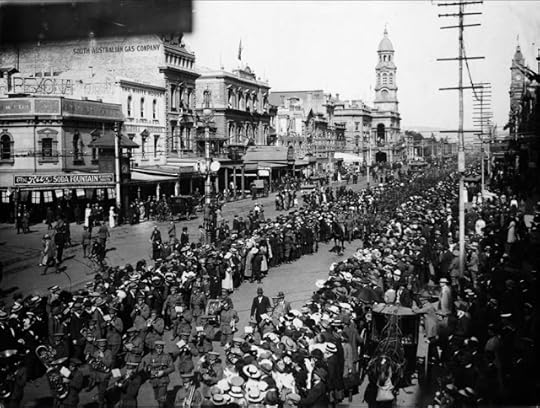 A military band leading South Australian soldiers as they make a farewell march along King William Street, Adelaide before going overseas in World War I; large crowds line the roadside on both sidesSLSA: [PRG 280/1/3/339]
A military band leading South Australian soldiers as they make a farewell march along King William Street, Adelaide before going overseas in World War I; large crowds line the roadside on both sidesSLSA: [PRG 280/1/3/339]April 23, 2024
Gawler's Dark History Presentation - 11 May 2024.
Join Me on Saturday 11th of May for a late afternoon talk about Gawler's Dark History!
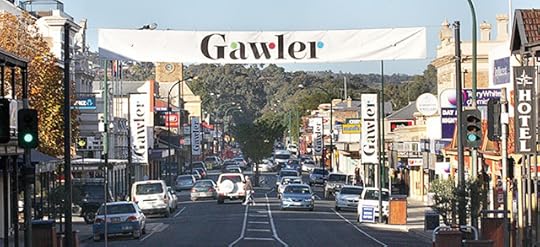
I'll be detailing some shocking local murders, suicides, nasty accidents, and maybe a ghost or two! This event is strictly 18+ as some of the details are rather gruesome!
This is a fundraiser event for the Gawler National Trust Museum to help raise some much-needed money for the upkeep of Gawler's historical museum.
I'll also have books available for sale and signing (EFTPOS available).
$15 per person, 11 May 2024 4:00 PM - 5:30 PM.
Tickets are almost sold out so get in while you still can!
Gawler National Trust Museum - 59 Murray Street Gawler, SA 5118
https://www.eventbrite.com.au/e/gawle...?
#history #allentiller #gawler #truecrime
Loveday – Part 2: The Murder of Francesco Fantin
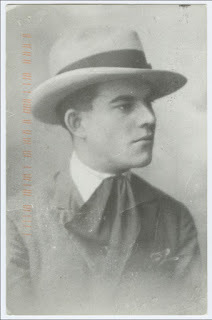 Portrait of Francesco G. Fantin 1920 [SLSA: B 75173]
Portrait of Francesco G. Fantin 1920 [SLSA: B 75173] The Italian antifascistinternees in Loveday organised a money raising event called ‘Sheepskins forRussa’, which was associated with the defence of Stalingrad, Francesco Fantinwas heavily involved in this campaign, which provoked the fascists in the camp.
A newspaper arrived in the camp on November 16 1942, dated two days earlier,that referred, by name, to some of the Loveday internees who had helped raisemoney for Russia. This led to anger within the fascist factions, and during adinner discussion, it was agreed the fascists should be killed as traitors.
Around 6:30 pm, on the 16th of November 1942, GiovanniBruno Casotti, who had arrived at the South Australia camp only two weeks priorfrom Western Australia, approached Fantin from behind. Fantin was standing at adrinking tap, Casotti struck Fantin from behind with a large piece of wood.Fantin fell, and as he did, Casotti kicked him in the groin and head.
Fantin was carried to his bunk in his tent. Fascist and camp leader, DrPiscitelli was called to attend. Pisctelli was not willing to treat Fantin, soFantin was taken to the base hospital where he was attended by Dr AdrianoMugga. Mugga stated that Fantin’s neck was broken, his skull fractured, andseveral ribs cracked. The military base doctor, Dr. Luke Verco was called toattend. Dr Verco stated that Fantin had a cerebral haemorrhage, caused by thefractured skull, and had Fantin moved to the Barmera Base Hospital, whereFentin would die of his injuries that night at 10:25 pm.
Witness recollections of the event differ between fascistand anti-fascist accounts. The fascists claimed that the evening of the event,Casotti had met Fantin between Huts 3 and 4, when Fantin has called to him.Casotti claimed that Fantin was happy that Italians were dying in the war andthat all the fascists were being killed. Casotti then claimed that Fantin hadstarted insulting his family, so he pushed Fantin, with both his hands onFantin’s chest. As Fantin fell, his head hit the water tap, and this is whatcaused his injuries.
Casotti’s version of events was supported by most internees in the camp. Themajority being fascists.
The anti-fascist version of events included witness accountsfrom Augusto Pretti, who claimed he saw Casotti strike Fantin with a piece of3x2x2 wood on the head, then hit him in the ribs with the same piece of timber.Pretti claimed that Casotti then began kicking Fantin.
Domencio Franchici stated that he, and others, say Casotti hit Fantin in thehead with the wood, kick him over the heart; on the ribs, and groin and privateparts.
Most antifascist internees were too terrified to speak out, as they believedthey would meet the same fate.
Casotti was charged with manslaughter, but his case wasdeferred while more evidence was collected. When court resumed CrownProsecutor, Mr Chamberlain claimed that his new evidence would prove Casottimurdered Fantin.
K.H. Kirkman, the Deptuy Director of Security in South Australia and Master ofthe Supreme Court became involved. Correspondence began with the Director ofGeneral Security, Brigadier General W.B. Simpson in Camberra. It was decidedthat the murder charge should not be pursued in the courts as it would bringprotests and further complications for the military and the camp.
The trial resumed on March 16 1943, with Casotti foundguilty of manslaughter. He was sentenced to two years hard labour at YatalaLabor Prison.
Francesco Fantin became a martyr for the anti-fascist movement in Australia. After his death, Australian anarchists, anti-fascists and communists protested his murder. Joan Finger of the Political Rights Committee campaigned that maladministration at the Loveday camp and a military coverup had occurred. The North Queensland Guardian, a communist newspaper, declared that no antifascist should be in internment camps.[8]
A bi-lingual theatre production, written by Teresa Crea,titled ‘Red Like the devil’, about Fantin’s life and murder, was performed atthe Loveday internment camp where Fantin was attacked. The play opened at thePlayhouse Theatre in Adelaide on October 29, 1991, and was presented by DoppioTeatro.
Researched and written by Allen Tiller © 2024[1] Paul Nursey-Bray, 'Anti-Fascism and Internment: The Case of Francesco Fantin,' Journal of the Historical Society of South Australia, Number 17, (1989), pp. 88-111.
[2] Ibid.
[3] Tommy Lawson, ‘Francesco Fantin, Italian Anarchism and Anti-Fascism in Australia’, lib.com, (2022), https://libcom.org/article/francesco-....
[4] Statement made by Mumu Augusto Pretti to Sgt R. De Rosa, A.A. (A.C.T ). C.R.S. A373, Item: Box 21, 10913.
[5] 'FATAL FACTION QUARREL', The Advertiser, (17 March 1943), p. 6.
[6] Nursey-Bray, 'Anti-Fascism and Internment,' Journal of the Historical Society of South Australia, pp. 88-111.
[7] 'TWO YEARS HARD LABOUR FOR INTERNEE', Murray Pioneer, (1 April 1943), p. 1.
[8] Nursey-Bray, 'Anti-Fascism and Internment.' Journal of the Historical Society of South Australia, pp. 88-111.
[9] Gordon Sheldon, 'No title', The Canberra Times, (17 October 1991), p. 13.
April 16, 2024
Loveday – Part 1: The Murder of Francesco Fantin
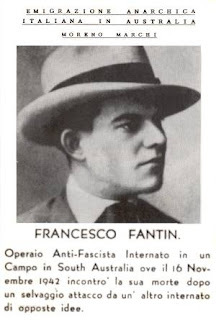
In December 1942, The Sydney Tribune ran the headlines‘ANTI-FACIST MURDERED: Political Terrorism in S.A.’ World War II was raging, and in Australia,Japanese, Germans and Italian people had been segregated into internment campswith many arriving in the South Australian outback camp, Loveday, the largestcamp of its kind in Australia.
Loveday was established in 1941, near Bamera, holding over5000 internees, and 1500 staff comprised from the Australian Military Forces.It also held, at times, Prisoners of War. The camp was established by theAustralian government to hold people it labelled ‘enemy aliens,’ typically,these were people from countries that Australia and its allies had declared waragainst.
According to the Loveday Lives website,of 15000 internees across the group of camps during its usages, 7000 were inAustralia at the outbreak of the war, and 8000 were transported from the UnitedKingdom and Dutch East Indies through arrangements by their government.
In June 1941 the 4thGarrison Battalion arrived at Loveday to begin Guard duty. Later that month thefirst internees, a group of 458 Italians arrived at the camp from Hay in NewSouth Wales. In august 1941, the firstinternational internees arrived, sent from Britain after the fall of France.The first Japanese internees arrived from the Northern Territory in January1942, with German and more Italians arriving the same month.
In 1943, the camp reached 5382 internees. The camp closed in 1946 – for moreinformation about the history of the camp and a timeline of significant eventsplease visit: https://lovedaylives.com/
One internee at Loveday was Italian Franceso Fantin. Fantinwas born in San Vito di Leguzzano in North Italy in 1901. Fantin was a textileworker in Italy. The rise of Fascism in Italy saw Fantin become an anarchistand political militant. Fantin left Italy in 1927, arriving at Melbourne,before moving to Queensland where his brothers, Luigi and Alfonso had a canefarm at Sawmill Pocket, Edmonton.
In the 1930s, Fantin had moved to Victoria, where he becameactive in the Labour and anti-fascist movements. He became a correspondent forthe anti-fascist newspaper La Risoccossa. Fantin was arrested byAustralian authorities in 1940 as a fascist. He appealed the decision, butlost, and was sent to Loveday Internment Camp 14A at Barmera. Unlike otherinternment camps, Loveday separated internees by nationality, not politicalaffiliation, which led to a political divide between those detained. Fantinstood with the anti-fascist, and became a political leader, which led toconstant harassment, abuse, and assault from fascist detainees. Anotherdetainee entered Fantins tent and beat him senseless. Fantin reported theassault, but the authorities would not get involved.
In 1942, near sunset,on November 16, Fantin was drinking from a water tap. He was alone when fascistsupporter, Giovanni Bruno Casotti, a detainee who had arrived only two weeksprior from Western Australia, assaulted him. There are two versions of events,which I will discuss in part two.
Researched and written by Allen Tiller © 2024
‘History’, Loveday Lives, (2023), https://lovedaylives.com/history/.
PaulNursey-Bray, 'Fantin, Francesco Giovanni (Frank) (1901–1942)', AustralianDictionary of Biography, National Centre of Biography, Australian NationalUniversity,https://adb.anu.edu.au/biography/fant....
March 5, 2024
The Ghost of Cream Puff Corner
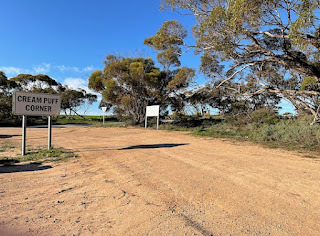
Cream Puff Corner is located at Upper Yorke Rd, Wokurna,near Port Broughton. The location got its name from two returned servicemen,Cedric Witty and David Richards, who began a carrying business at this locationin 1946. According to a sign at the location,
‘When local folk asked the boys how they managed “batching”,the answer was always the same. “Real good, living like lords, we knock up abatch of cream puffs every Sunday morning.”
From then on, they were always asked “How’s the cream puffs going?”
“Real good,” they’d answer, “but we only manage them on Sundays.” When askedthe whereabouts of their bachelor cottage, they’d laconically answer, “CreamPuff Corner of course!”
It has long been reported that the location is haunted by anunidentified man in a checked shirt. Have you seen him? Do you know who hemight be?
Please let us know!
February 6, 2024
Schoolmasters of the Gawler Primary School 1878 - 1978
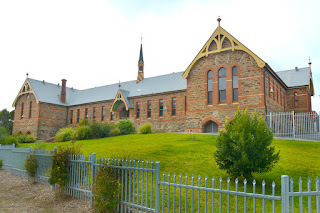
1878-1881- L. S. Burton
l88l -1887-1. A. Plummer
1887-1891- John Harry
1891-1895- R. T. Burnard
1895-1897 - John Donnell
1897-1905 -Alfred Holloway
1905- 1913-Oliver D. Jones
1913 -George S. Berriman
1913-1927-Evan Thomas (Edward D. Nicholas-Acting HeadTeacher for a period in 1919, during the illness of Mr Thomas)
(Ernest H. Priest-Acting Head Teacher for part of 1926-1927,during Mr. Thomas' long illness, before his retirement)
1927-1929-Roy Bromley
1929-1930-William J. Fisher
I1930-1932- Alfred J. Keats
1932-1942- William J. Barbary
1942-1945- Martin J. Hansberry
1945- 1948- Roland S. Michelmore
1948- 1950-E. Ray Sexion
1950- 1951 -John T. Blizard
1951 -l 954-Ronald C. Bierwirth
1954-1956-Walter R. Hayward
1956- I 960- Héctor McKenzie
1960 – 1962 -J. C. Nadebaum
1962-1964-Michael l. Jones
1964-1969-Eric Riley
1969-1972-Ronald Krieg
1973 -F. l. Barnett
1974-1976- J. Hurn
1977- -Don. Paterson
The 1888 Tragedy at Semaphore.
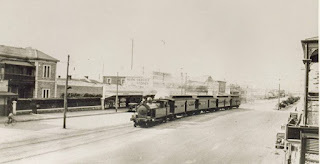
In 1888, the newspapers of the day were scathing of20-year-old Susan Schmidt, who on February 8th, had ridden on the footboard ofa train carriage travelling to Semaphore. As the train crossed the points, itshook, dislodging Susan and throwing her under the train where she was crushedto death.
It came to light that Susan and a friend, Emma Fitts, hadleft Susan's parents’ house in the evening, and walked to Port Adelaide. Theysaw a friend off at Alberton station, then walked back to Exeter station, whenthe Semaphore bound train arrived. Rather than walk, they hopped onto thesteps of the train from the opposite side of the platform. William Uden,travelling in the train, told the girls they had better get off the train, butthey ignored him. As the train entered Semaphore station and crossed thepoints, it made a slight jump, dislodging Susan, who was flung under the train.
Porter, Charles White, who was on his way to the points, sawthe train give a little jump and heard someone yell out from under the train.He was first to see Susan on the rails and went immediately for a doctor. Whenthe train stopped at Semaphore, the guard William Swann, saw the danger lightslit up at the points by White and could see Susan lying around 100 yards fromthe train.
There was little compassion in South Australia’s media ofthe day. The South Australian Register wrote, ‘Susan Schmidt was run over andkilled by the Semaphore train on February 8, owing to her recklessness inunlawfully riding on the footboard of the carriage.’
The Evening Journal stated, ‘A Sad Death from Recklessness –It must be a painful reflection for the parents of the poor girl, SusanSchmidt, who was run over and killed by the Semaphore train…’
The Port Augusta Dispatch wrote, ‘Susan Schmidt tried toride on the step of a Semaphore railway carriage last Wednesday. Verdict –nobody but herself to blame.’
Susan's body was transported to the Port Hospital where DrToil examined her, before placing her dead body in the morgue.Susan's lower body had been ‘completely crushed.’
An inquest into the death occurred at the Port Admiral Hotelon February 9, 1888, overseen by Coroner T. Ward. J.P. Susan’s father Bennett Schmidt gave evidenceat the inquest, stating,
She was 20 years of age last September. Last saw her aliveabout half-past 7 on Wednesday evening in company, with., two friends. Theyleft his place and went in the direction of the Semaphore-road. Was awakenedabout a quarter past 10 by Mr. Warn, who told him of the accident. Directly sawit was his daughter that had been run over. She asked him to lift her up, andrepeated the question in the train. She never told him how the accidentoccurred. Never knew deceased to be reckless.
The jury returned a verdict that ‘the deceased met her deathby being run over by the Semaphore train, the accident is caused by herattempting to ride on the step of the carriage and added a rider that no blamewas attached to anybody.
Researched and written by Allen Tiller © 2024
[1] 'Latest News.', Evening Journal, (9 February 1888), p. 2. (SECOND EDITION).[2] 'ABSTRACT OF NEWS.', South Australian Register, (13 February 1888), p. 7.
[3] 'S.A. SWIMMING CLUB.', Evening Journal, (10 February 1888), p. 3. (SECOND EDITION).
[4] 'Grape Shot.', The Port Augusta Dispatch, Newcastle and Flinders Chronicle, (14 February 1888), p. 2.
[5] 'Latest News.', Evening Journal, (9 February 1888), p. 2. (SECOND EDITION).
[6] Ibid.
[7] 'CORONERS' INQUESTS.', South Australian Register, (10 February 1888), p. 7.
[8] Ibid.



